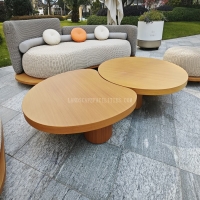Welcome to the website for landscape facilities products and knowledge.
What are the implications of using smart materials in landscape table construction?
The integration of smart materials into landscape table construction is revolutionizing outdoor design by combining functionality, sustainability, and innovation. These advanced materials, such as shape-memory alloys, self-healing polymers, and photovoltaic composites, offer unique benefits that traditional materials cannot match.
One of the most significant implications is enhanced durability. Smart materials can adapt to environmental changes, such as temperature fluctuations or moisture exposure, reducing wear and tear. For instance, self-healing concrete can repair minor cracks autonomously, extending the lifespan of outdoor tables.
Sustainability is another critical advantage. Photovoltaic-integrated tables can harness solar energy to power embedded lighting or charging stations, promoting eco-friendly urban spaces. Additionally, recyclable smart materials align with circular economy principles, minimizing waste.
Adaptive functionality sets smart material tables apart. Thermochromic coatings can change color based on temperature, creating dynamic visual effects, while shape-memory alloys allow tables to adjust their form for optimal comfort or space efficiency.
However, challenges like high costs and technical complexity remain. Despite this, the long-term benefits—reduced maintenance, energy efficiency, and aesthetic versatility—make smart materials a compelling choice for future-forward landscape design.
In conclusion, smart materials are redefining landscape table construction by merging cutting-edge technology with sustainable practices, paving the way for smarter, greener outdoor spaces.
Related search:

Recommendation
Elliptical metal outdoor table with nested design, resembling wood grain, round table